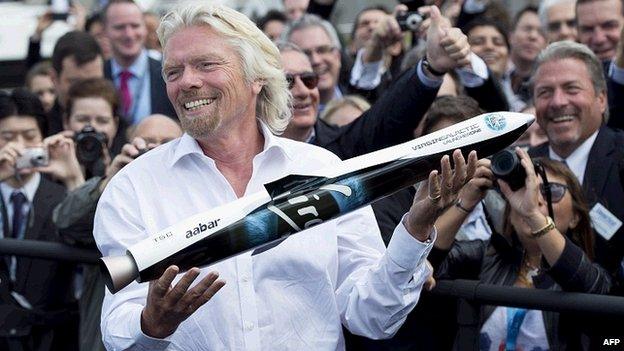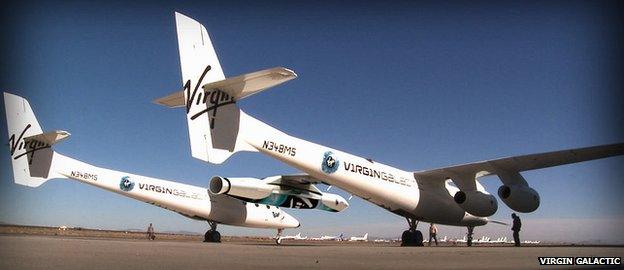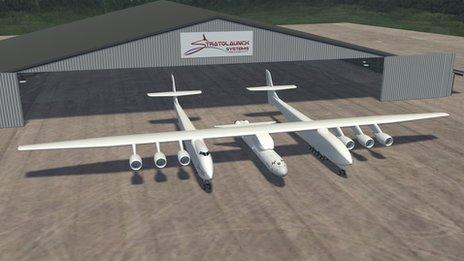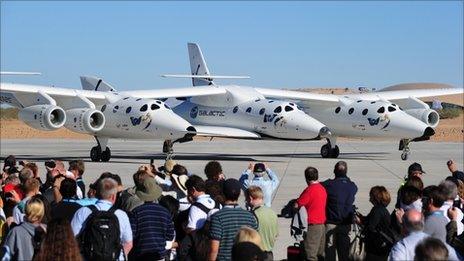Richard Branson's Virgin Galactic to launch small satellites
- Published
- comments

Sir Richard has been mulling the idea of a satellite launcher for a number of years
Virgin Galactic is pushing ahead with its small satellite launch system.
The company started by UK billionaire Sir Richard Branson is primarily focused on taking fare-paying passengers into space.
But the technology being developed to take up people could also be adapted to send aloft smaller Earth observation and communications spacecraft.
Sir Richard confirmed details of his LauncherOne concept at the Farnborough International Airshow.
"I believe this vehicle will create a long overdue shake-up of the whole satellite industry, disrupting current norms and limitations in exactly the way that SpaceShipTwo has for human space travel and space-based science research," he told a special media event.
"This confidence comes from more than a natural optimism because even before its official launch, we have four private companies who've already put down deposits as future customers, expressing their intent to purchase multiple satellite launches."

LauncherOne is slung beneath WhiteKnightTwo and carried to 50,000ft before release
A rocket to put spacecraft in orbit is something Virgin Galactic has been talking about since 2009, external but which was put on the backburner while the company concentrated on its SpaceShipTwo passenger vehicle.
LauncherOne would look much like the current Pegasus system, which is operated by Orbital Sciences Corporation, external.
This uses a former airliner to lift a booster to 40,000ft, before releasing it to make its own way into orbit.
The booster ejects the satellite a few hundred kilometres above the Earth. This is how Nasa launched its most recent mission in June - the Nustar X-ray Observatory.
But many small satellite operators say Pegasus is priced out of their reach, and Virgin Galactic believes its air-launched alternative could be made significantly cheaper.
"We're going to keep our design simple - use a lot of proven technologies. We're not about to prove new advanced systems," explained chief technical officer, Steve Isakowitz.
"Addtionally, and this is key, we're looking to maximize and leverage what we're already doing on the WhiteKnight and spaceship programme."
In-house design
The concept calls for a two-stage rocket that would be powered by engines burning liquid oxygen and kerosene.
The vehicle should be capable of lofting payloads of up 225kg (500lb) into low-Earth orbits, and for a price below $10m.
Virgin has recruited a dedicated team to design and build LauncherOne in Mojave and Pasadena, California.
The maiden flight is expected in 2015 with commercial operations starting in 2016.
Part of the reason the company thinks it can lower costs is because, unlike Pegasus, it already has a carrier aircraft - the same plane that will be lifting the passenger spaceship to its launch altitude.
And WhiteKnightTwo, or "Eve" as this aircraft is known, is going to be kept extremely busy, making for a very efficient operation.
"We're going to keep our design simple - use a lot of proven technologies. We're not about to prove new advanced systems," explained chief technical officer, Steve Isakowitz.
"Additionally, and this is key, we're looking to maximize and leverage what we're already doing on the WhiteKnight and spaceship programme."
Not just people

In its passenger role, WhiteKnight will deliver SpaceShipTwo to the launch altitude
Virgin announced here at Farnborough that it has now taken deposits from 529 people who want to fly in space.
These are people who will have to part with $200,000 (£128,000) before they board SpaceShipTwo. All have been promised they will fly within the first couple of years of operation. Sir Richard himself says he hopes to ride into space in 2013.
The LauncherOne proposal is part of Virgin Galactic's strategy to diversify its business.
It also wants to work with governments and institutions that might want to fly scientific experiments in the high atmosphere or in the weightless conditions experienced on a sub-orbital flight.
Virgin Galactic says it already has firm commitments to use LauncherOne. Among these promises is Planetary Resources Inc, external, the newly announced, billionaire-backed asteroid mining venture.
Market opportunities
But Virgin is also attracting interest from well established small spacecraft manufacturers, such as the UK's Surrey Satellite Technology Limited, external (SSTL).
It has signed a memorandum of understanding with Branson's company, and will be looking at how to optimize its payloads for the new rocket system.
Currently, a customer buying a satellite from SSTL will use the British firm to also source a launch opportunity for them as well.
This has become a complex process for Surrey in recent years. It has pioneered the use of former Russian ballistic missiles but booking reliable launch dates is far from simple, and the price of these ex-military vehicles is also going up.
In future, SSTL hopes to offer LauncherOne as part of its satellite package.
"This is a market stimulus if we can reach the right price point for launch vehicle and satellite bus together," said Dr John Paffett from Surrey's US office.
"Today, the market is being stifled in some instances by the costs associated with getting the payload into orbit. If collectively we can reduce that price further then I am sure it will open up the market for all of us," he told BBC News.
- Published14 December 2011

- Published18 October 2011

- Published31 March 2011
- Published23 October 2010
- Published11 October 2010
- Published2 October 2010